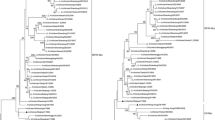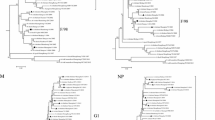Abstract
The first recorded outbreak of avian influenza (AI) in South African chickens (low pathogenicity H6N2) occurred at Camperdown, KwaZulu/Natal Province (KZN) in June 2002. To determine the source of the outbreak, we defined the phylogenetic relationships between various H6N2 isolates, and the previously unpublished gene sequences of an H6N8 virus isolated in 1998 from ostriches in the Leeu Gamka region (A/Ostrich/South Africa/KK98/98). We demonstrated that two distinct genetic H6N2 lineages (sub-lineages I and II) circulated in the Camperdown area, which later spread to other regions. Sub-lineages I and II shared a recent common H6N2 ancestor, which arose from a reassortment event between two South African ostrich isolates A/Ostrich/South Africa/9508103/95 and (H9N2) A/Ostrich/South Africa/KK98/98 (H6N8). Furthermore, the H6N2 sub-lineage I viruses had several molecular genetic markers including a 22-amino acid stalk deletion in the neuraminidase (NA) protein gene, a predicted increased N-glycosylation, and a D144 mutation of the HA protein gene, all of which are associated with the adaptation of AI viruses to chickens. The H6N2 NS1 and PB1 genes shared recent common ancestors with those of contemporary Asian HPAI H5N1 viruses. Our results suggest that ostriches are potential mixing vessels for avian influenza viruses (AIV) outbreak strains and support other reports that H6 viruses are capable of forming stable lineages in chickens.






Similar content being viewed by others
References
D.J. Alexander, B. Dodet, M. Vicari (eds.), John Libbey Eurotext, (Montrouge, France, 2001), pp. 25–34
D. Halvorson, D. Karunakaran, D. Senne, C. Kelleher, C. Bailey, A. Abraham, V. Hinshaw, J. Newman, Avian Dis. 27, 77–85 (1983)
M. Liu, Y. Guan, M. Peiris, S. He, R.J. Webby, D. Prerz, R.G. Webster, Avian Dis. 47, 849–856 (2003)
D.L. Suarez, Vet. Microbiol. 74(1–2), 15–27 (2000)
P.S. Chin, E. Hoffmann, R. Webby, R.G. Webster, Y. Guan, M. Peiris, K.F. Shortridge, J. Virol. Jan, 507–516, 2002
M.S. Lee, P.C. Chang, J.H. Shien, M.C. Cheng, H.K. Shieh, J. Virol. Methods 97(1–2), 13–22 (2001)
E. Hoffmann, J. Stech, Y. Guan, R.G. Webster, D.R. Perez, Arch. Virol. 146, 2275–2289 (2001)
T.A. Hall, Nucl. Acids Symp. 41, 95–98 (1999)
S. Kumar, K. Tamura, M. Nei, Brief. Bioinform. 5, 150–163 (2004)
J. Pasick, H. Weingartl, A. Clavijo, J. Riva, H. Kehler, K. Handel, E. Watkins, K. Hills, Avian Dis. 47(3), 1208–1213 (2003)
S. Pfitzer, D.J. Verwoerd, G.H. Gerdes, A.E. Labuschagne, A. Erasmus, R.J. Manvell, C. Grund, Avian Dis. 44, 655–660 (2000)
R.J. Manvell, C. English, P.H. Jorgensen, I.H. Brown, Avian Dis. 47(3), 1150–1153 (2003)
A. Clavijo, J. Riva, J. Pasick, Avian Dis. 47(3), 1203–1207 (2003)
G. Luo, J. Chung, P. Palese, Virus Res. 29, 141–153 (1993)
M. Matrosovich, N. Zhou, Y. Kawaoka, R.G. Webster, J. Virol. 73, 1146–1155 (1999)
R. Wagner, T. Wolff, A. Herwig, S. Pleschka, H.D. Klenk, J. Virol. 74, 6316–6323 (2000)
R.J. Webby, P.R. Woolcock, S.L. Krauss, D.B. Walker, P.S. Chin, K.F. Shortridge, R.G. Webster, Avian Dis. 47(3), 905–910 (2003)
P.R. Woolcock, D.L. Suarez, D. Kuney, Avian Dis. 47(3), 872–881 (2003)
Acknowledgements
We wish to thank Ruth Manvell for re-supplying a stock of the H6N8 virus, Margaret Parker, Raina Maharaj, Boto Ganzevoort, C Mutlow, S Abrahams and Elsa Cornelius for excellent technical assistance and Marco Romito for critical review of the manuscript.
Author information
Authors and Affiliations
Corresponding author
Additional information
The nucleotide sequence data reported in this paper have been submitted to the GenBank nucleotide sequence database and have been assigned the accession numbers DQ408506-DQ408529.
Rights and permissions
About this article
Cite this article
Abolnik, C., Bisschop, S., Gerdes, T. et al. Outbreaks of avian influenza H6N2 viruses in chickens arose by a reassortment of H6N8 and H9N2 ostrich viruses. Virus Genes 34, 37–45 (2007). https://doi.org/10.1007/s11262-006-0007-6
Received:
Accepted:
Published:
Issue Date:
DOI: https://doi.org/10.1007/s11262-006-0007-6




